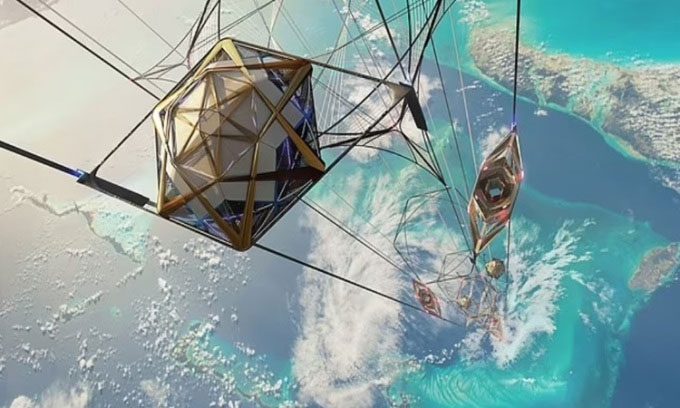The new space elevator design project could revolutionize space travel at a much lower cost compared to rocket launches, as awarded by the Jacques Rougerie Association in December 2023.
Jordan William Hughes, an engineer from Barrow, introduced a plan for a space elevator that would make journeys into space as simple as stepping into an elevator, Mail reported on January 16. Hughes won a $10,914 prize from the Jacques Rougerie Association for designing a system to transport passengers and cargo into space. His design, named Ascensio, will include an extremely long cable anchored to an asteroid in geostationary orbit with a floating platform on Earth. Drones carrying passengers and cargo could move up and down the cable like trains on vertical tracks.

Space elevator design by Jordan William Hughes. (Photo: Jordan William Hughes).
This revolutionary form of space travel could replace inefficient rockets with a cable connecting Earth to satellites in orbit, according to Hughes. He also believes that the space elevator could become a key means of transportation in the future.
Six drones, including three for cargo and three equipped with windows and life support for humans, will travel along the cable to a space station. This space station will be located at an altitude of 36,000 km above Earth, which is over 78 times higher than the International Space Station (ISS). However, this station will resemble a train station with multiple exits rather than a final destination. Hughes does not want the design to be purely functional. Therefore, he has added many luxurious amenities such as a swimming pool, a zero-gravity walking path, and a viewing area for Earth. At the other end of the cable, the architect designed a floating island with landscaped gardens and attractions.
The floating island allows the entire elevator to be moved to avoid storms on Earth or space debris. This will enable space travel to be less dependent on weather conditions, a major issue for current commercial missions.
<pHowever, the main advantage of the space elevator is that it makes traveling to space much cheaper. Rocket flights are extremely costly and inefficient due to the enormous thrust required to escape Earth’s gravity. For example, launching a Falcon 9 rocket to the ISS at an altitude of 460 km currently costs $67 million. However, in the long run, the cost of traveling via the space elevator could be reduced to just a few dollars.
There are several technical challenges preventing the space elevator from becoming a reality, with the biggest issue being new materials. The cable connecting Earth to the space station needs to withstand immense tension due to gravitational and centrifugal forces acting on it in opposite directions. Currently, no material is both lightweight and strong enough to meet this requirement.
In 2018, the Japanese construction company Obayashi announced that they are exploring ways to create a space elevator to transport tourists by 2050, with an estimated cost of $7.6 billion. The most promising proposal so far is to use carbon nanotubes, a structure made from carbon atoms, to produce ultra-light cables.





















































